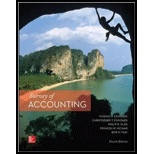
a.
Prepare income statement using FIFO and LIFO.
a.
Explanation of Solution
Income statement: The financial statement which reports revenues and expenses from business operations and the result of those operations as net income or net loss for a particular time period is referred to as income statement.
Prepare income statement using FIFO as follows:
| Company W | |
| Income Statements (FIFO) | |
| For the Year Ended December 31, XXXX | |
| Particulars | Amount |
| Sales revenue (1) | $175,000 |
| Less: Cost of Goods Sold Table (2) | ($104,300) |
| Gross Margin | $70,700 |
| Less: Operating Expenses | ($21,000) |
| Income Before Tax | $49,700 |
| Less: Income Tax Expense (3) | ($14,910) |
| Net Income | $34,790 |
Table (1)
Working note 1: Calculate the sales revenue.
Working note 2: Calculate cost of goods sold amount under FIFO:
| Computation of cost of goods sold | |||
| Particulars | Unit | Unit cost | Total cost |
| Purchases: | |||
| January 1 | 300 | $25 | $7,500 |
| April 1 | 2,800 | $30 | $84,000 |
| October 1 | 400 | $32 | $12,800 |
| Cost of goods sold | 3,500 | $104,300 | |
Table (2)
Working note 3: Calculate income tax expense amount:
Prepare income statement using LIFO as follows:
| Company W | |
| Income Statements (LIFO) | |
| For the Year Ended December 31, XXXX | |
| Particulars | Amount |
| Sales revenue (4) | $175,000 |
| Less: Cost of Goods Sold Table (4) | ($107,000) |
| Gross Margin | $68,000 |
| Less: Operating Expenses | ($21,000) |
| Income Before Tax | $47,000 |
| Less: Income Tax Expense (6) | ($14,100) |
| Net Income | $32,900 |
Table (3)
Working note 4: Calculate the sales revenue.
Working note 5: Calculate cost of goods sold amount under LIFO:
| Computation of cost of goods sold | |||
| Particulars | Unit | Unit cost | Total cost |
| Purchases: | |||
| October 1 | 1,000 | $32 | $32,000 |
| April 1 | 2,500 | $30 | $75,000 |
| Cost of goods sold | 3,500 | $107,000 | |
Table (4)
Working note 6: Calculate income tax expense amount:
b.
Ascertain the amount of income tax that would be saved by Company W if it changes the cost flow method.
b.
Explanation of Solution
Income Tax Expenses: The expenses which are related to the taxable income of the individuals and business entities for an accounting period, and are recognized by them for the purpose of federal government and state government tax are called as income tax expenses.
- The amount of income tax that paid by Company W under FIFO cost method is $14,910.
- The amount of income tax that paid by Company W under LIFO cost method is $14,100.
The income tax saved by Company W is calculated as follows:
Thus, Company W would save $810 if it changes the cost flow method from FIFO method to LIFO method.
c.
Ascertain the
c.
Explanation of Solution
Cash flows from operating activities: This section of cash flow statement provides information about the cash received or cash paid in day-to-day operating activities of a company.
Ascertain the cash flow from operating activities under FIFO and LIFO as follows:
| Company W | ||
| Cash Flows from Operating Activities | ||
| Particulars | FIFO | LIFO |
| Cash Flows From Operating Activities: | ||
| $175,000 | $175,000 | |
| Less: | ($116,000) | ($116,000) |
| Cash Outflow for Operating Expense | ($21,000) | ($21,000) |
| Cash Outflow for Income Tax Expense | ($14,910) | ($14,100) |
| Net Cash Flow from Operating Activities | $23,090 | $23,900 |
Table (5)
Working note 7: Calculate cash outflow for Inventory amount:
d.
Describe why cash flow from operating activities is lower under FIFO when that cost flow method produced the higher gross margin.
d.
Explanation of Solution
The cash flow from operating activities is lower under FIFO method because more amount of income tax has to be paid on the amount of income before tax reported under FIFO. Thus, more amounts of cash have been expensed for operating activities that lowers the net cash flow from operating activities.
Want to see more full solutions like this?
Chapter 5 Solutions
Survey Of Accounting

 AccountingAccountingISBN:9781337272094Author:WARREN, Carl S., Reeve, James M., Duchac, Jonathan E.Publisher:Cengage Learning,
AccountingAccountingISBN:9781337272094Author:WARREN, Carl S., Reeve, James M., Duchac, Jonathan E.Publisher:Cengage Learning, Accounting Information SystemsAccountingISBN:9781337619202Author:Hall, James A.Publisher:Cengage Learning,
Accounting Information SystemsAccountingISBN:9781337619202Author:Hall, James A.Publisher:Cengage Learning, Horngren's Cost Accounting: A Managerial Emphasis...AccountingISBN:9780134475585Author:Srikant M. Datar, Madhav V. RajanPublisher:PEARSON
Horngren's Cost Accounting: A Managerial Emphasis...AccountingISBN:9780134475585Author:Srikant M. Datar, Madhav V. RajanPublisher:PEARSON Intermediate AccountingAccountingISBN:9781259722660Author:J. David Spiceland, Mark W. Nelson, Wayne M ThomasPublisher:McGraw-Hill Education
Intermediate AccountingAccountingISBN:9781259722660Author:J. David Spiceland, Mark W. Nelson, Wayne M ThomasPublisher:McGraw-Hill Education Financial and Managerial AccountingAccountingISBN:9781259726705Author:John J Wild, Ken W. Shaw, Barbara Chiappetta Fundamental Accounting PrinciplesPublisher:McGraw-Hill Education
Financial and Managerial AccountingAccountingISBN:9781259726705Author:John J Wild, Ken W. Shaw, Barbara Chiappetta Fundamental Accounting PrinciplesPublisher:McGraw-Hill Education





